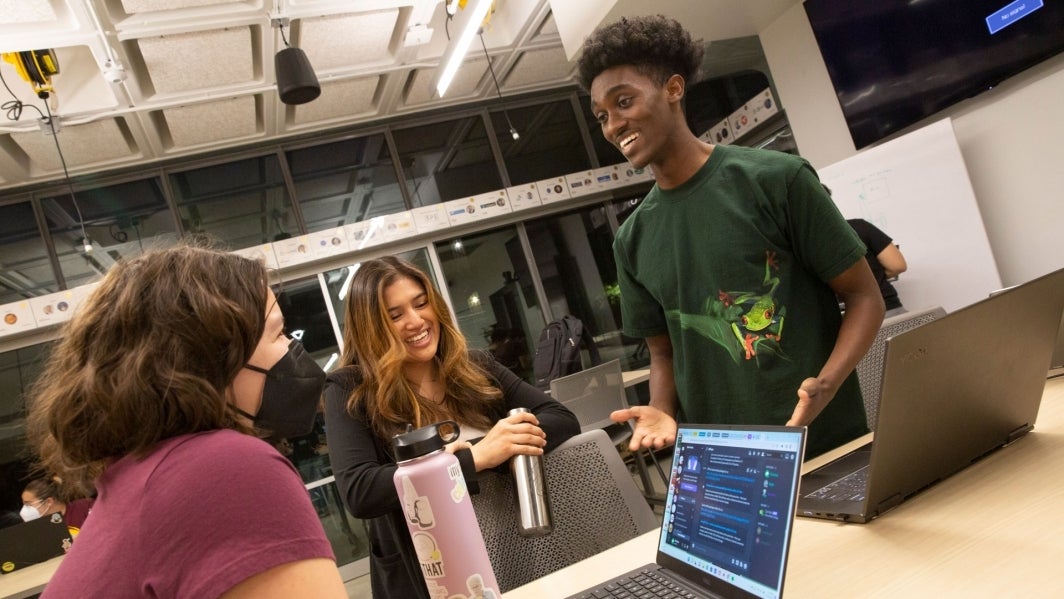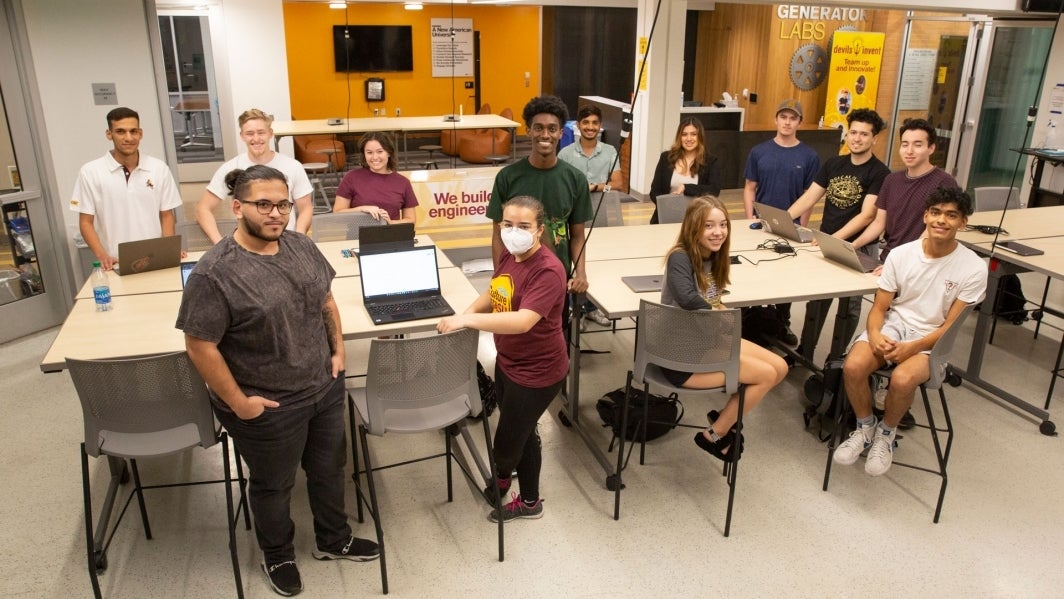A solar-powered learning experience

Ayman Hangalay (right), a recent mechanical engineering bachelor’s degree graduate and the 2021—22 president of Solar Devils, works with mechanical engineering majors Christina Sturgeon (left) and Denisha Nez (center) during one of the student organization’s design meetings. Photo by Erika Gronek/ASU
In the Valley of the Sun, Arizona State University students are embarking on a journey to build a solar-powered car from the ground up. As members of the Solar Devils student organization, they are in the driver’s seat for a unique, hands-on experience unlike anything they’ve done in class.
The finish line will be at the 2023 American Solar Challenge, where the Solar Devils will put their car to the ultimate test in a multi-day, cross-country race covering more than 1,500 miles.
Ayman Hangalay, who graduated from the Ira A. Fulton Schools of Engineering at ASU in May with his bachelor's degree in mechanical engineering, was the team’s president for the 2021—22 academic year. He helped start the team in the summer of 2021 because he wanted to get more practical engineering experience and build something from scratch.
“I was fascinated by the vehicles other universities in the same competition were able to create,” Hangalay says, “and that inspired me to rise to the challenge of trying to emulate that at ASU.”
In the organization’s first year, Hangalay and the team of approximately 30 students learned a lot, and the experience has fueled their interest in renewable energy and solar technologies.
Navigating a steep learning curve
So far, the team has completed a mountain of background research to learn how to design a solar-powered car, created digital models with computer-aided design, or CAD, software and started purchasing sample parts to begin testing.
Some of the work requires students to apply the skills they learn in their majors. Hangalay drew on his experience as a mechanical engineering major to help design the solar car.
“Designing components of the vehicle relies on the fundamentals of structural mechanics: the exterior shell on aerodynamics and fluid dynamics, the battery system-to-solar panel hookup on circuitry knowledge, and CAD skills to perform all computer-designed models and simulations for testing,” he says. “The engineering curriculum at ASU does a good job of teaching the fundamentals that end up finding their way into all aspects of the building process.”
He says the process of working on this unique and complex project also involves applying many concepts that he never would have learned in class.
“Some of the biggest skills that we had to obtain were understanding how to design for assembly and manufacturing, the necessary implementations for cars like crumple zones in the chassis design, and considering the economics of sourcing and manufacturing,” Hangalay says.
In addition to all the regulations to which their car has to adhere, the Solar Devils team has also had a lot of design decisions to make, from three-wheeled to four-wheeled configurations, and how they contributed to the car’s weight, stability, construction simplicity and surface area for solar panels.
“Making a racing car from scratch that runs on solar power is a huge project with lots of logistics to take care of,” says Anoop Grewal, a lecturer in the Fulton Schools who serves as the Solar Devils faculty adviser. “The students get to learn a lot of practical lessons they will not get in classes, such as how to source parts, how things fail in real life, manufacturing issues and more.”
In addition to all the testing and trials of each system, the team also must work with sponsors to get the necessary funding to build such a car, which could cost as much as $30,000.
Grewal recalls a talk that a Tesla Motors engineer gave to the group. The engineer emphasized simply making a car that works in the first attempt and saving the performance optimization for the second attempt. Grewal and Hangalay believe Solar Devils students are doing just that — learning the necessary skills on the fly and taking it one step at a time.
“It is one thing to learn concepts in the classroom and an entirely different thing to go from the initial brainstorming stage all the way to the manufacturing and testing stages of a car you helped build by hand,” Hangalay says. “Students will experience many challenges and learn how to overcome the natural failure that they will experience in industry.”
Collaborating with a multidisciplinary team of all skill levels
The Solar Devils team includes primarily mechanical and aerospace engineering majors, but Hangalay says students in all majors are encouraged to join. Some students on the project are in the civil engineering, computer science and computer systems engineering programs.
The members also range from first-year students to graduate students.
“This creates a really important dynamic because students with more experience in specific areas are integral for teaching and explaining the more complex topics,” Hangalay says.
Christina Sturgeon, a rising mechanical engineering sophomore pursuing a minor in sustainability, joined Solar Devils in her first year to get more hands-on experience, apply her classroom knowledge and pursue her passion for sustainability and renewable energy. She has been able to apply both the problem-solving skills and technical skills she has already learned with new skills she gained.
“The work in Solar Devils has also given me exposure to topics I had yet to learn about as a freshman,” she says. “It is really exciting to get to work on an actual project and apply skills from all different classes to create something new.”
Sturgeon says she has benefited from working on the interdisciplinary, multi-level team so early in her academic career.
“You have students at all different age levels who are contributing knowledge,” she says. “As a first-year student, I learned so much from upperclassmen while working on this project.”
The difficulty of learning so much new information is also one of the biggest rewards, Sturgeon says.
“It is intimidating at first, but once you get into it and do more research, it is so exciting to learn more,” she says.
Hangalay says that first-year students are eager to learn new concepts, noting that through Solar Devils, many first-year students started to practice designing with SOLIDWORKS CAD software a year before they learn about it in the engineering curriculum.
In addition to their faculty adviser’s knowledge, the group can also learn from the many solar power experts among the Fulton Schools faculty members.
“ASU has a lot of great professors who are really knowledgeable in the solar industry to provide advice and feedback whenever we need it,” Hangalay says. “They provide great support to engineering clubs.”
Working toward a bright renewable energy future
Hangalay is proud of the progress the team has made by working together every week to achieve their shared goal.
There have been many surprises along the way, and Hangalay says the biggest revelation for him was seeing the simplicity of electric vehicle motors compared to gas-powered vehicle motors.
“This project has made me more confident in the future of electric vehicles as a whole,” Hangalay says.
Based on their experience with the project, Hangalay and Sturgeon say they see the possibility down the road of using solar power in electric vehicles.
Upon his graduation, Hangalay passed the steering wheel to president-elect Mateo Oliveras, a mechanical engineering major. Hangalay is excited to see where the organization will go in the coming years — through the American Solar Challenge, and maybe even to the Bridgestone World Solar Challenge, an 1,800-mile race across the Australian Outback.
“This is such a special project because it not only gives students an opportunity to engage in a challenging and incredibly rewarding experience,” Hangalay says, “but we’re also helping shape future engineers who will hopefully gain interest in renewable energy and change the world for the better.”
The Solar Devils experience helped Hangalay land a job as a mechanical design engineer with Boeing in Seattle. The project is preparing others for their careers as well.
“Ultimately, (this experience) makes students great candidates for amazing job and internship opportunities,” Grewal says. “It also makes the students a lot more entrepreneurial. They will have the necessary skills to start their own thing if they want to.”
Sturgeon is excited about pursuing opportunities to do solar power research and a career in the renewable energy sector. Solar Devils is giving her and other students the skills to achieve such goals.
“This project is so much fun and I believe anyone interested in renewable energy and engineering would love working on it,” she says. “Solar Devils provides a lot of experience with vehicles in general, as well as in electric vehicles, and we have areas of work for anyone in engineering to make a contribution.”
Interested in joining Solar Devils? The team is looking for new members to join the electrical team — especially upper-division students, but all are welcome. Join the Solar Devils Discord and follow the team on Instagram @asusolardevils to find out about upcoming general meetings and work meetings.
More Science and technology

ASU postdoctoral researcher leads initiative to support graduate student mental health
Olivia Davis had firsthand experience with anxiety and OCD before she entered grad school. Then, during the pandemic and as a…

ASU graduate student researching interplay between family dynamics, ADHD
The symptoms of attention deficit hyperactivity disorder (ADHD) — which include daydreaming, making careless mistakes or taking…

Will this antibiotic work? ASU scientists develop rapid bacterial tests
Bacteria multiply at an astonishing rate, sometimes doubling in number in under four minutes. Imagine a doctor faced with a…


